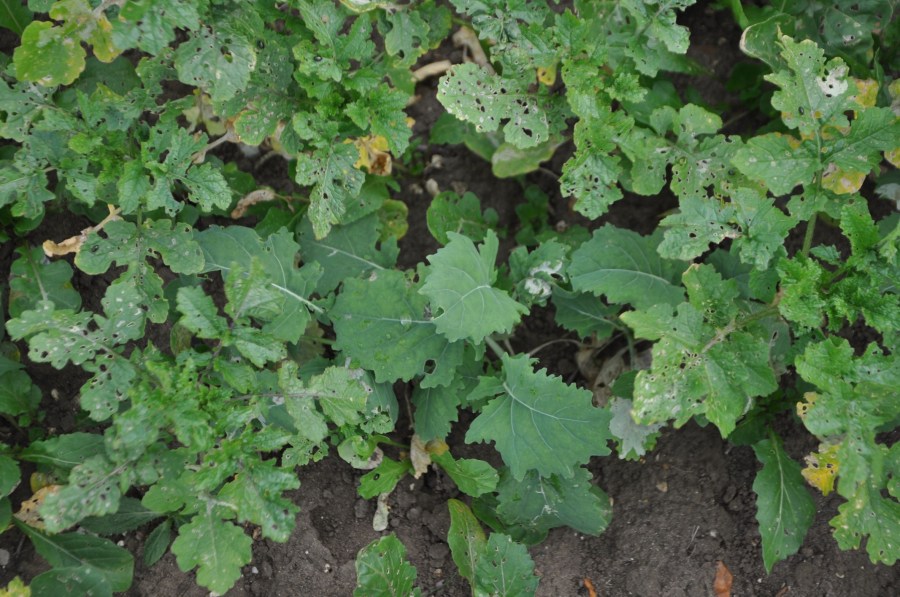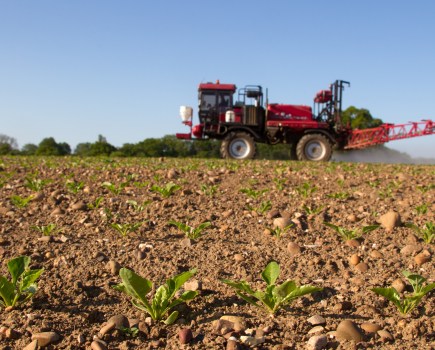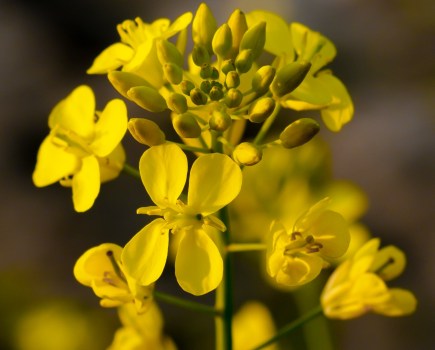Cabbage stem flea beetle has ascended to the status of major pest in some regions over the past three seasons. CPM finds out about a companion crop that may offer a solution to the problem.
Options for controlling cabbage stem flea beetle (CSFB) in oilseed rape are fairly limited, especially with resistance to pyrethroids on the rise and the ban on neonicotinoids. Cultural control strategies that reduce reliance on the can are being looked at as a way of keeping OSR viable in CSFB-affected areas, where there‘ve been numerous instances of severe crop damage or complete crop loss due to adult feeding and subsequent larval damage.
Potential investigated
The potential for white mustard as a companion crop is being investigated in a series of BASF-sponsored trials. The aim is to help alleviate problems by reducing the level of CSFB grazing in OSR crops.
Small plot experiments in recent seasons have suggested white mustard grown amongst or next to OSR plants may reduce grazing damage by adult beetles, says Clare Tucker, business development manager for BASF.

Clare Tucker announces BASF is sponsoring further trials to assess the potential of white mustard to help control CSFB.
″NIAB-TAG has played a pioneering role in this field, carrying out two years of successive trials looking at different options that might be effective as companion crops. According to initial results, white mustard looks to have the most potential.“
As a result, NIAB-TAG will be extending its work on the concept this season, both independently and in collaboration with BASF. In parallel, BASF is also setting up its own grower trials to test the concept further, she explains.
Optimum population
Several seed rates will be assessed in both trials, to help identify the optimum population of white mustard that will offer the best degree of protection, while causing the least competitive impact on the OSR crop, says Clare.
“It’s important to carry out detailed research on this because there‘s a fine balance between the companion crop working as an effective deterrent to the beetle whilst not damaging yield potential – white mustard is a vigorous plant.”
Both sets of BASF-sponsored trials will use Clearfield OSR varieties, which will enable the white mustard to be controlled effectively with Clearfield herbicides, without risk of crop damage, once the OSR is established and beyond the high-risk period of adult grazing, she adds.
“It’s not enough for a companion crop to reduce pest pressure at the critical time. Growers also have to be able to remove it from the crop, otherwise it can compete and affect yields. The herbicides which can be used in Clearfield give good control of white mustard, so it’s a good option.”
Simon Kightley, NIAB-TAG’s OSR specialist, says experiments carried out in 2015 and 2016 indicated some scope for reducing grazing damage by the adult beetles, with white mustard showing the most promise.
Exciting discovery
At one site near Cambridge, this technique provided the only protection for OSR plants in 2016, when all other OSR trials and mixtures in companion crop experiments were wiped out by the pest, he adds.
“I‘m really excited about this discovery. In a field of 24ha, the only surviving plants last year were within a small number of plots with the white mustard mix. I just can’t wait to get going with the new planting season to validate the concept.”
The BASF-sponsored NIAB-TAG work will be carried out at three regional sites, says Jane Kitchen, BASF’s OSR Campaign Manager.
Plant counts and feeding damage assessments will be taken from emergence through the following two months. Larval counts will be taken in early spring, and plots will be taken to yield. BASF’s grower trials, supported by the company’s agronomy managers, will test the approach on farm and gain feedback on its practical application, she explains.
“All agronomic inputs on the crops will remain unchanged, and the timing of the Clearfield herbicide application is likely to be around mid-Oct. We think this technique has potential to alleviate early feeding pressure and help crops get through the critical early emergence and growing phase, when plants are at their most vulnerable.
“If this approach proves to work, it‘ll go a long way towards restoring grower confidence by ensuring successful establishment in those areas where flea beetle is starting to be a worry, and perhaps even in the worst-hit hotpots.”
The NIAB-TAG trials haven’t gone unnoticed by OSR breeder, DeKalb. “Alongside our own European work, the NIAB-TAG trials clearly identify white mustard as the most promising OSR companion to combat flea beetle attack,” agrees Dekalb marketing manager, Deryn Gilbey.

Deryn Gilbey says DeKalb is interested in the potential of white mustard with Clearfield varieties to help reduce flea beetle damage, and offered 100 free 1ha packs of DK Imperial CL blended with the mustard this autumn.
“In addition to the Cambs site, where the only plots to survive where the ones containing white mustard, in trials at Morley under relatively low CSFB pressure, reduced grazing was recorded in the white mustard treatment compared with the OSR alone or with other companion mixes.
“More backward crop development at flowering was also recorded at Morley – attributed to early competition from the mustard’s particularly rapid autumn growth – and this was identified as a clear concern by NIAB-TAG,” he notes.
Clearfield system
“We see the Clearfield system as an ideal technical solution here. As well as allowing crops to be grown without any possible check to establishment from either pre-em herbicides or SU residues, it means the white mustard crop can be reliably eliminated, along with other competitive weeds and any non-CL volunteers, with an early post-emergence Clearfield herbicide spray.”
This autumn Dekalb were offering free 1ha packs of DK Imperial CL blended with white mustard seed, with the aim of gaining grower insight into the effectiveness of the companion crop in a commercial situation.
“We need to understand the extent white mustard will attract flea beetles away from OSR on a field scale. If it does this reliably enough, it could make all the difference. As well as being a valuable way of countering the early risk from adult beetle grazing, it’s possible diverting egg-laying to companion plants (that are then destroyed early) could help reduce future infestation pressures.”




